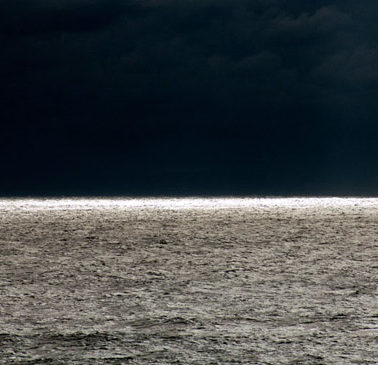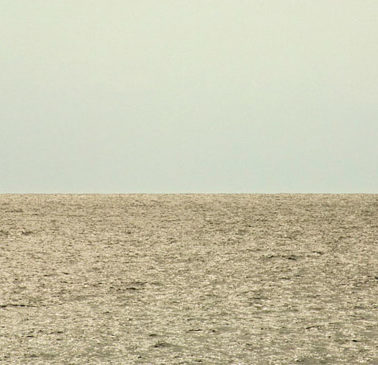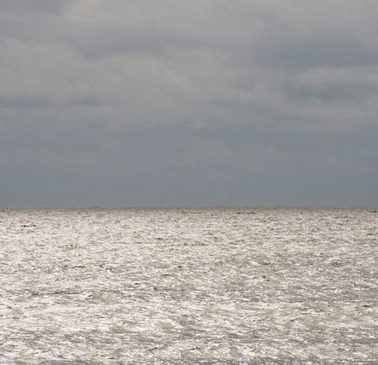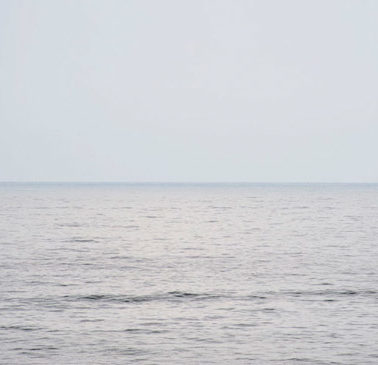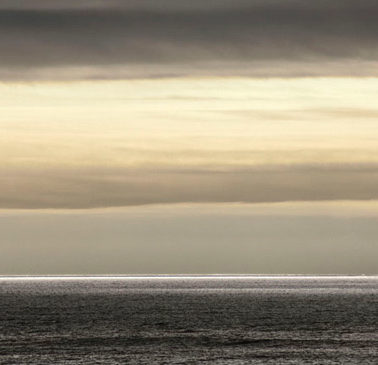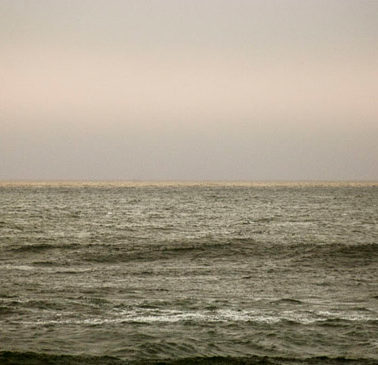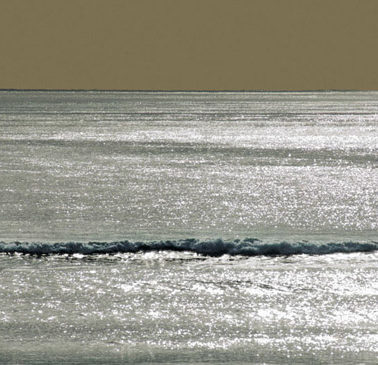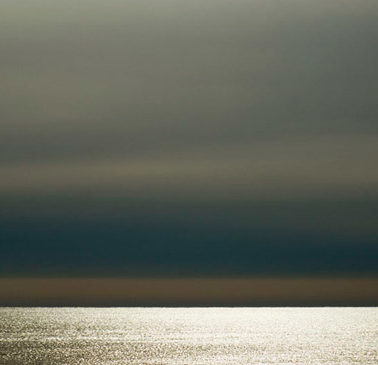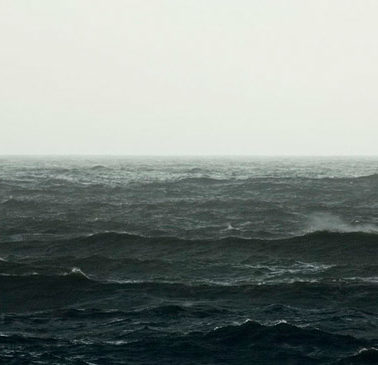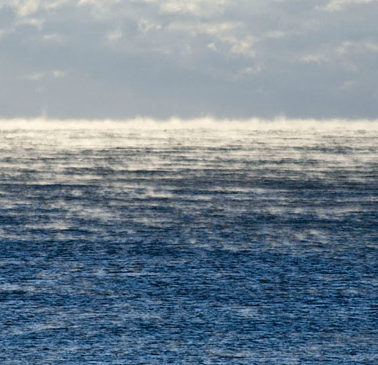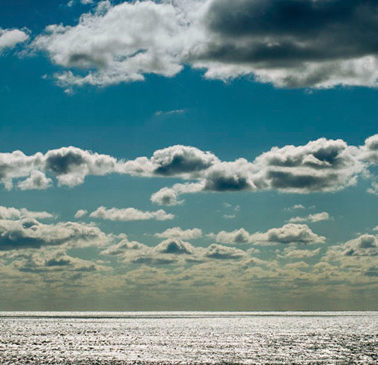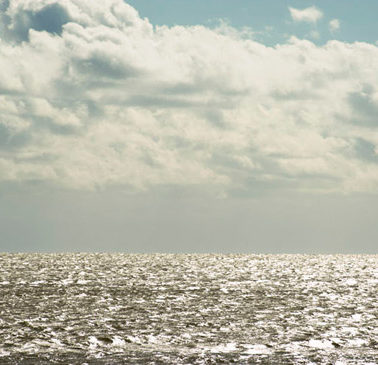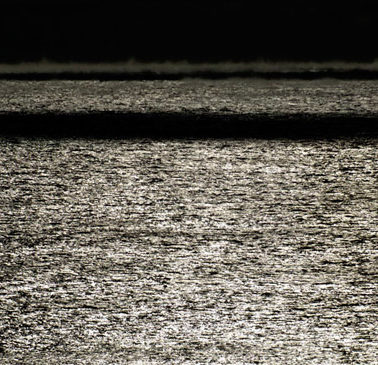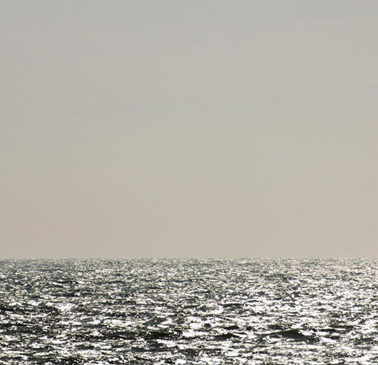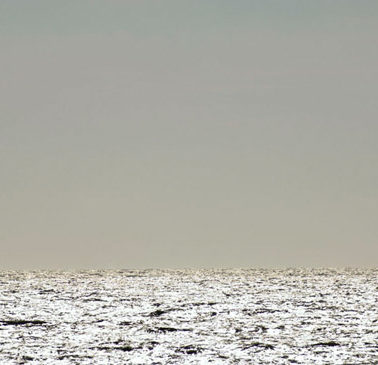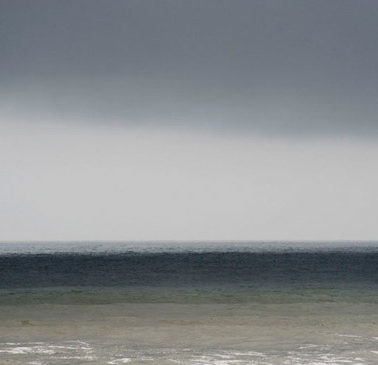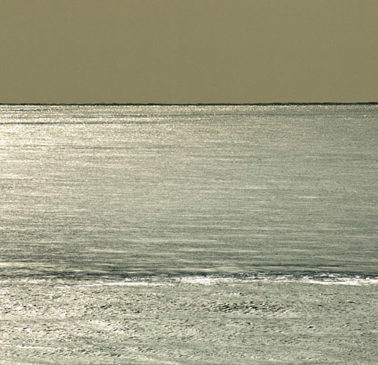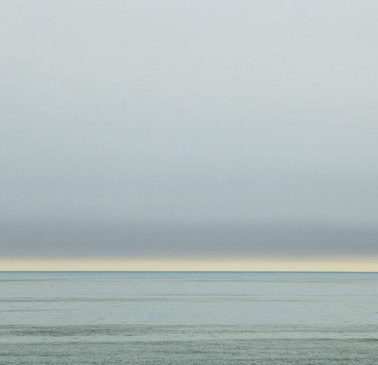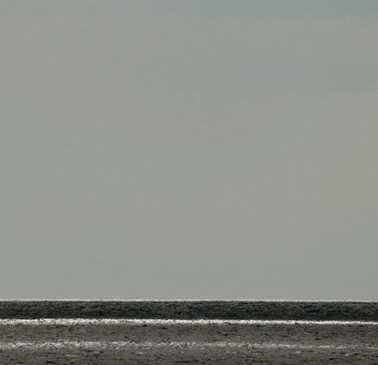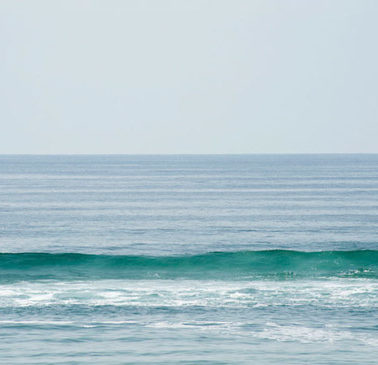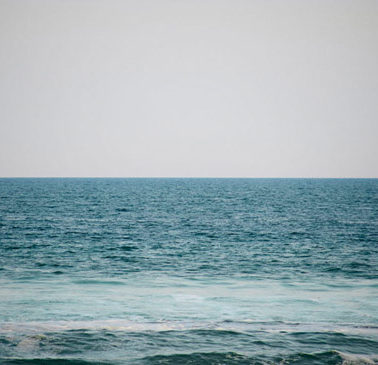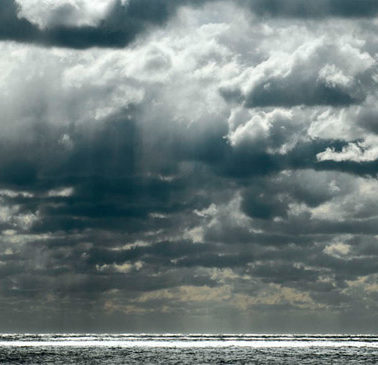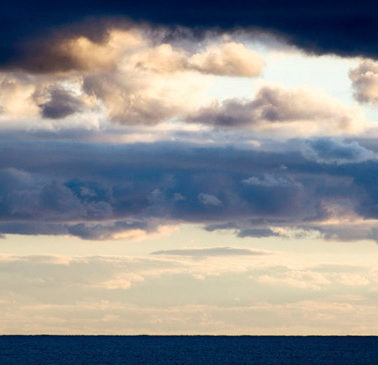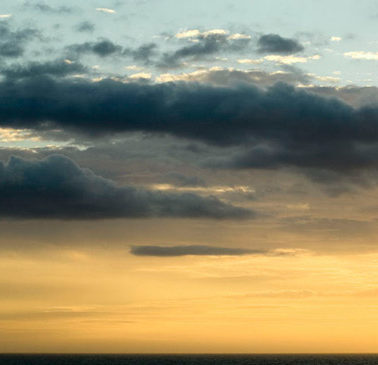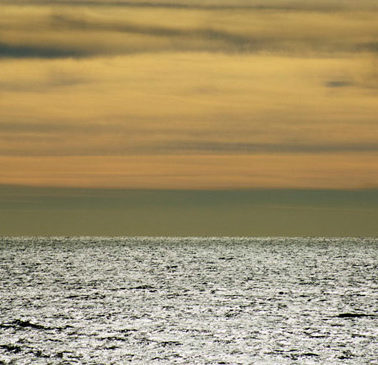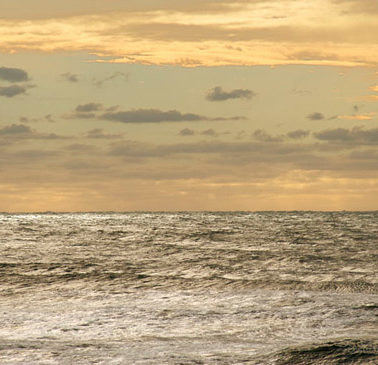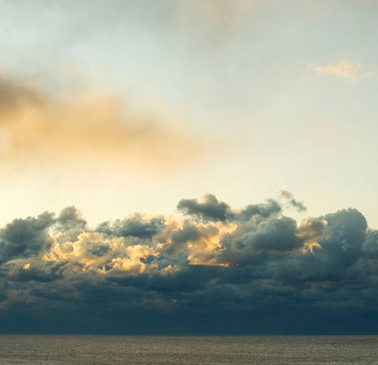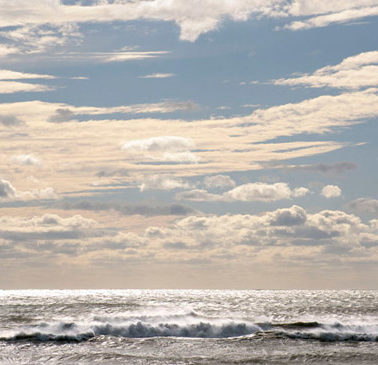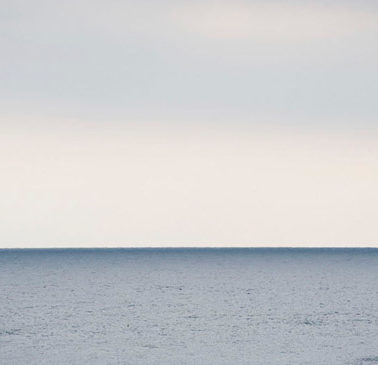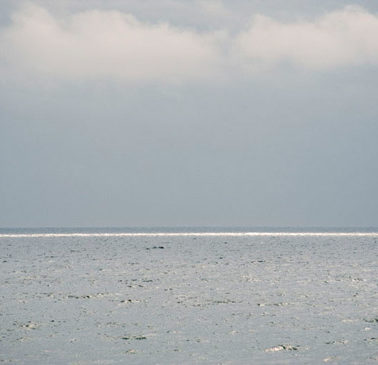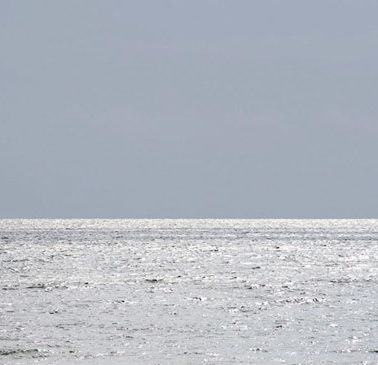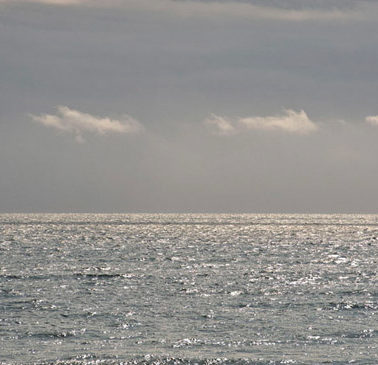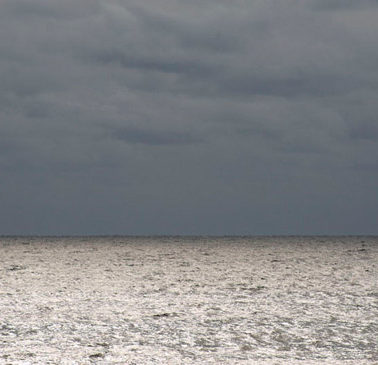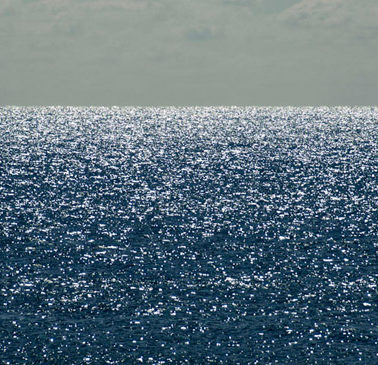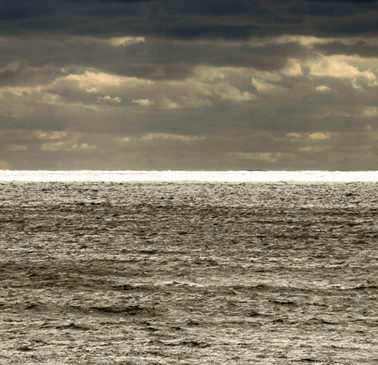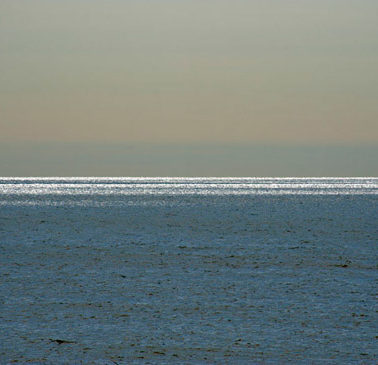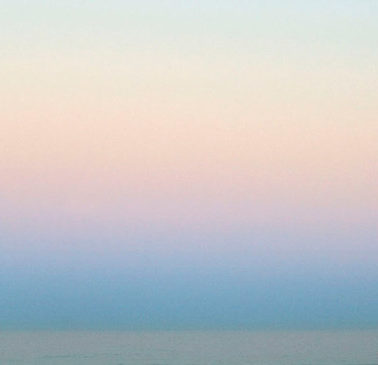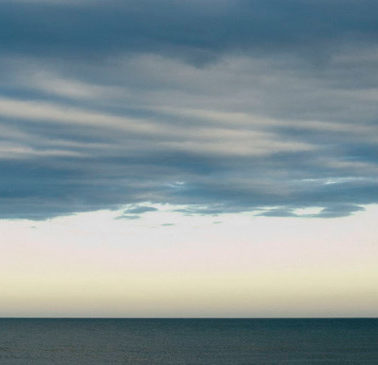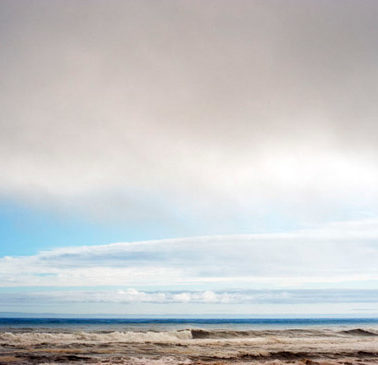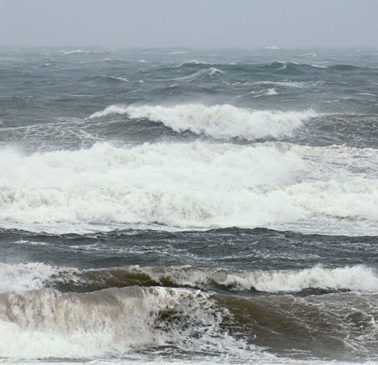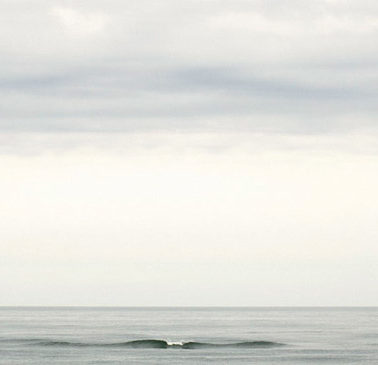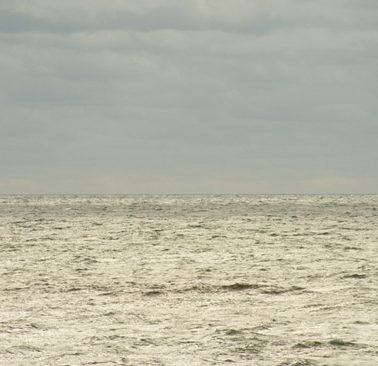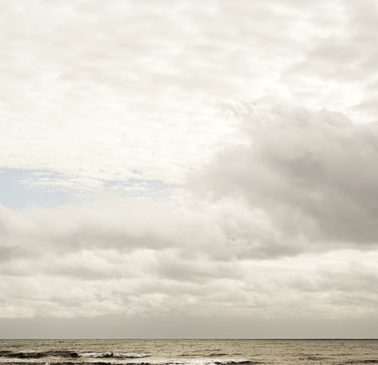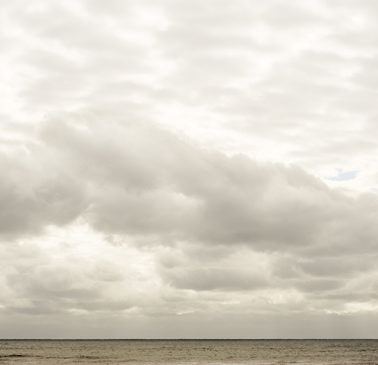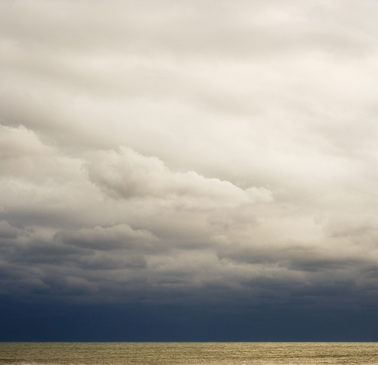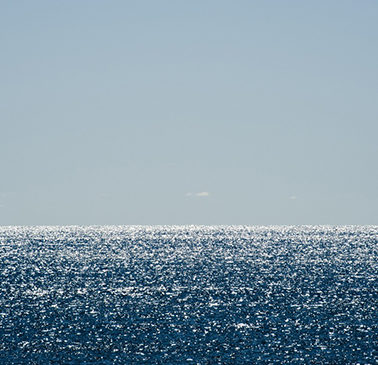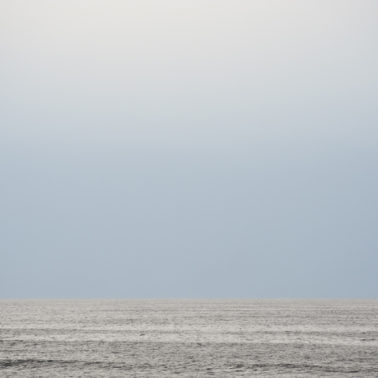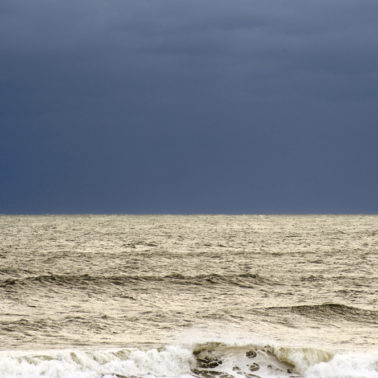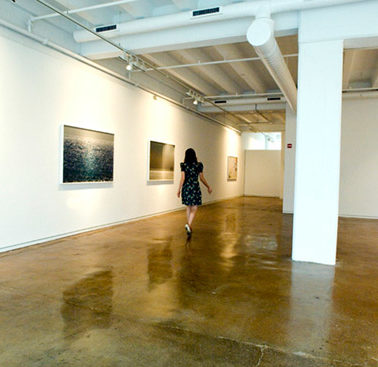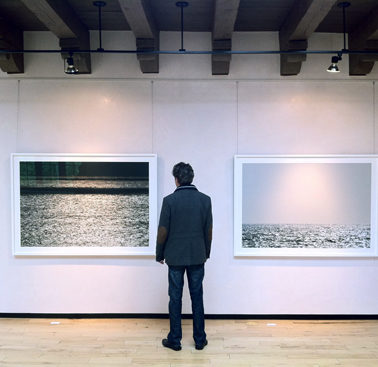Project and Book (published in collaboration by Kehrer Verlag, Germany and Radius Books, Santa Fe , NM)
Ongoing project.
Limited edition prints
Image size:
58 x 89 edition 3
40 x 60 edition 3
28 x 40 edition 10
USA
Visit Adamson Gallery, Washington, D.C.
Visit Chiaroscuro Contemporary Art, Santa Fe, NM
Europe
Visit Robert Morat Galerie, Berlin, Germany
The Book: Oceanscapes – One View, Ten Years
Visit coastalcare.org
INTERFACES
by Petra Roettig
Renate Aller’s Oceanscapes seem to depict infinity. For more than ten years, 1999 to present, the artist photographed the sea from the same point on Long Island. The photographs show the dynamics of sky and water, reflection and currents. Depending on weather conditions and time of year, the resulting images may be either dramatically expressive, or peaceful melancholic abstractions. One moment the sea seems to swallow the horizon in its endlessness, another moment the transient phenomena of light and cloud dominate. Like the seventeenth century Dutch landscape painters who depicted a towering sky above a narrow strip of water, Aller also understands the sea-level plane as an endless horizontal space. The fascinating aspect of Renate Aller’s photographs however is the changing interface, the seam between heaven and earth. Sometimes it is glistening and sharp-edged, where the elements seem to be reversed, appearing like the color fields of a Rothko painting, placed one above the other; sometimes it is fluid and soft, with a barely perceptible dividing line an almost sandy-looking, choppy sea and a flawless blue sky. Thus Aller’s images become a theatre of continual change.
Renate Aller’s photographs follow the law of the series. This notion of the serial, capturing the changing mood of nature from a constant standpoint has been an established concept within art history since Monet’s Haystacks or Rouen Cathedral series. Monet’s identical views, reflecting one motif in varying light and weather conditions became a splendid triumph of art. Possibly for the first time an artist had dared to create a series of different images starting with only one motif. Monet was less interested in the motif than in the sudden moment, the shifting sensory impressions and perceptions in the human eye. Influenced by scientific discoveries and by photography, still in its infancy, Monet attempted to record “what I sense and perceive”.[i] Like French impressionist Monet, in her photographs Renate Aller also conveys the fleeting moment, which only halts for an instant then threatens to vanish again. Temporal succession is defined through the changing light conditions alone. Although the ephemeral nature of this moment is clear in Renate Aller’s photographs, at the same time it seems to have been frozen solid. Some of her shots seem almost meditative. At sunset, for instance, ocean and sky seem to fuse together in a neon illuminated field of colour reminiscent of James Turrell; the deep black of the night rests like an impenetrable mass above the shimmering surface of the sea, a glistening bright line dividing them. We are continually amazed by the unexpected moods and effects of nature presented here, skillfully restaged by Aller.. Looking at the photographs we become hungry for more images, never tired of seeing the changes in the elements despite the repetitive motif. The longing to capture the moment, coupled with the simultaneous wish for change, holds us spellbound and constitutes the distinguishing element of Aller’s photography.
Beside the almost static sea pictures, the cloud studies feel like fleeting heavenly scapes moving by swiftly. Since the early nineteenth century, artists such as Constable or Johann Georg Dillis, “searching for the truth of nature” have transposed the phenomena of the skies with painterly and scientific precision into images. Dillis too continually sketched the fleeting movement of rolling clouds from the same position. He succeeded – much like Aller with her photographs – in reproducing the fluid structures of a natural theatre illuminated by the sun. Acknowledging the ideas of the romantics, for Renate Aller, the photographer, the landscape image is much more than just a natural drama.Like Caspar David Friedrich, who saw his landscapes as bearers of political and social messages, for Aller the sea stands as a metaphor for memory and also for change. The sea as a continually renewed element, as a fluid and simultaneously constant entity, becomes an interface of socio-cultural experiences and changes. Just as tiny currents grow into huge waves, breaking on the horizon, upheavals, mutations and innovations take place. Broken lines gradually transition into seams as if the horizon mediates between the sea and the sky.
It makes sense to compare Renate Aller’s photographs with Hiroshi Sugimoto’s Seascapes, begun in 1980. But while Sugimoto’s photographs feel like finely constructed sacred compositions of an untouched nature, Aller’s images seem deeply real and at the same time poetic. The frequent painterly effects of her photographs are more closely reminiscent of Gerhard Richter’s 1969-1975 Seascapes. In these almost nostalgically beautiful images, Richter achieves a distance from the motif using his typical blurred technique of painting. In this way he avoids an idealisation of nature, which he describes as deceitful because the nature art seeks to idealise “is always against us in all its forms, possessing neither sense, nor mercy, nor empathy”.[ii] This distancing from the ideal also plays a significant role in Aller’s work. For her the returning movement of the waves reflects the rhythm of time. It is not only the beauty of the moment which counts, but the change it attests to. Nothing is certain; everything is in motion.
-Petra Roettig
Head of contemporary art at the Museum Hamburger Kunsthalle (curated more then 50 exhibitions in the Hamburger Kunsthalle, the most recent being: Olaf Metzel. Zeichnungen/drawings, Sigmar Polke. Kulturschablone,Thomas Demand. Camera, Heribert C. Ottersbach. Arkadia Block.)
[i] Cf. Ludger Derenthal: “Die Erziehung des Auges. Die serielle Photographie, das wissenschaftliche Experiment und Monets Getreideschober”, in Monets Vermächtnis. Serie, Ordnung und Obsession exhibition catalogue, (Hamburger Kunsthalle, 2001), pp. 23-28, this quotation, p. 27.
[ii] Quoted in Felix Krämer “Gerhard Richter. Seestücke”, in Seestücke –Von Max Beckmann bis Gerhard Richter exhibition catalogue, (Hamburger Kunsthalle 2007), pp. 110-117, this quotation p. 111.
——
[1] Cf. Ludger Derenthal: “Die Erziehung des Auges. Die serielle Photographie, das wissenschaftliche Experiment und Monets Getreideschober”, in Monets Vermächtnis. Serie, Ordnung und Obsession exhibition catalogue, (Hamburger Kunsthalle, 2001), pp. 23-28, this quotation, p. 27.
[1] Quoted in Felix Krämer “Gerhard Richter. Seestücke”, in Seestücke – Von Max Beckmann bis Gerhard Richter exhibition catalogue, (Hamburger Kunsthalle 2007), pp. 110-117, this quotation p. 111.
I LIKE THE HORIZONTAL LINE BETTER THAN EVERY OTHER LINE.
–Agnes Martin
by Richard B. Woodward
Photographers can roughly be divided into two prehistoric classes: hunters and cave dwellers.
The hunters, believing that good pictures can be found anywhere, open the door each day without a clear idea what they will bring back.
A hunger for adventure is one reason they first picked up a camera. Their elusive quarry knows no boundaries and can lead into rubble-strewn war zones or across the tended lawns of a new subdivision. Knowing that the only photographs worth taking are beyond imagining, hunters welcome charmed accidents and train to watch for them. Only when something catches their eye—a child crouching on a stoop, a dark silhouette against a white staircase—do they interrupt the random flow of life and attempt to trap it as an image.
Opposed to their methods are the cave dwellers, photographers who prefer the stay-at-home comforts of an environment they can more of less govern. Hoping to bar the door against the swirling chaos or flat monotony of the world outside, they may have sketched what they want to photograph, gathering inside all the pieces they think will be needed to complete their blueprint. Their work process involves adjusting these pieces, human and inanimate, until they correspond to the picture already formed in their mind.
Historians of photography have described this crude polarization with such terms as discoverers and fabricators, street and studio, windows and mirrors. The categories are porous—all pictures evolve out of other pictures—but artists since the first years of the medium have exhibited a penchant for one style or the other, and the philosophic opposition goes back at least as far as Aristotle and Plato.
Renate Aller’s photographs in this book represent a third way, even as they combine elements of both. Shot outdoors under conditions dictated by her huge, primitive, volatile subject, the Atlantic Ocean, they are a record of open water as it acts like a giant mirror, reflecting what is happening that second in the sky. They are not her staged inventions but instead represent a more or less faithful record of what she saw as she waited daily and hourly in the hope that something she found dazzling or strange would appear in the viewfinder of her camera.
And yet, each of these digital images was taken over 10 years in the same place, from the back of the beach house she shares with her husband on the southern shore of Long Island, New York. Like a studio photographer, she has severely restricted her formal vocabulary, choosing to vary only the placement of the horizon lines in the frame. The mighty unpredictability of the ocean has been domesticated, its windswept vastness contingently tamed by the rules she has set herself in making art.
By combining these two approaches, Aller’s photographs can be at once ravishingly sumptuous in the tradition of American and European romantic landscape, as well as cooly austere and in line with the reductivist laws of minimalist practice inherited from the 1960s. As a strategy for capturing nature’s quirky atmospheres, it is both smart and appealing. The startling range of colors and textures that has found here—the ocean’s surface resembling sheet metal one minute, and fur or scattered jewels or liquid graphite the next—would not be as apparent without the serial mode to guide us.
Critics have likened this series to Hiroshi Sugimoto’s seascapes from the early 1990s. But as his funereal black-and-white photographs chart the almost ghostly demarcaration between water and air, and as her work is distinguished by floating blocks of color, she prefers to identify more closely with Mark Rothko in his late paintings. Agnes Martin’s disciplined grids also seem ancestral as do Caspar David Friedrich’s brooding landscapes, cited by Aller herself as an inspiration. Her self portrait with her back to us against the blankness of the ocean invokes, Friedrich’s “Wanderer above the Clouds.”
But another German who looms behind these pictures may be her contemporary Andreas Gursky. His classic picture “Rhein” from 1996, in which he sliced and compressed the great Wagnerian river into bands of pale sky, green bank, and gray water–his own favorite photograph, by the way, taken not far from his Düsseldorf studio–might be seen as a template for Aller’s more rhapsodic set of variations.
Our appreciation of what she has done with these influences grows with the knowledge that she made her art simply by looking out her back door every day. Many other photographers, from Josef Sudek to Roy DeCarava to Sally Mann, have shown that you don’t need to travel far to find a worthy subject. It may or may not be significant that Aller, in aiming her camera eastward across the Atlantic Ocean, is also facing her native land thousands of kilometers away. She would certainly not be the first artist to grow homesick while trying to establish a footing in a new home.
The ocean is the ideal vehicle for such thoughts and since the time of Homer has served this function. In a celebrated passage from the opening chapter of “Moby Dick,” Melville notes the crowds that gather along the Hudson River on Aller’s adopted island of Manhattan, a Sunday sight that prompts him to wonder about the ceaseless attraction of the sea throughout the ages on spectators and artists alike:
“Circumambulate the city of a dreamy Sabbath afternoon. Go from Corlears Hook to Coenties Slip, and from thence, by Whitehall northward. What do you see?–Posted like silent sentinels all around the town, stand thousands upon thousands of mortal men fixed in ocean reveries….Strange! Nothing will content them but the extremest limit of the land….Yes, as every one knows, meditation and water are wedded for ever.”
Melville finds himself at a loss to explain the magnetic pull. “Why upon your first voyage as a passenger, did you yourself feel such a mystical vibration, when first told that you and your ship were now out of sight of land? Why did the old Persians hold the sea holy? Why did the Greeks give it a separate deity, and own brother of Jove? Surely all this is not without meaning. And still deeper the meaning of that story of Narcissus, who because he could not grasp the tormenting, mild image he saw in the fountain, plunged into it and was drowned. But that same image, we ourselves see in all rivers and oceans. It is the image of the ungraspable phantom of life; and this is the key to it all.”
Renate Aller’s studies of waves and clouds are just as worshipful toward the ocean and leave us just as empty-handed about its meaning, even though she has not risked wading in too deep and has instead been content to observe from shore. Her photographs, like Alfred Stieglitz’s “Equivalents” or William Eggleston’s “Wedgewood Blue,” are at one level nothing more than portraits of weather. One of the beauties of art, however, is that the most elemental things–when seen carefully, and in the right light, as here–are usually more than enough to sharpen our sense of connection to the world.
Richard B. Woodward
Richard B. Woodward has been an arts critic for The New York Times since 1995. Alongside New York Times, he also writes for The Wall Street Journal
Southampton, NY
